The Argentine presidential election of 1937 was held on 5 September 1937.
Contents
| ||||||||||||||||||||||||||||||||
| ||||||||||||||||||||||||||||||||
| ||||||||||||||||||||||||||||||||
| ||||||||||||||||||||||||||||||||
The Argentine presidential election of 1937 was held on 5 September 1937.
| ||||||||||||||||||||||||||||||||
| ||||||||||||||||||||||||||||||||
| ||||||||||||||||||||||||||||||||
| ||||||||||||||||||||||||||||||||
The 1931 elections (boycotted by the previous ruling party, the centrist Radical Civic Union) proved to be a precedent for the 1937 elections, called to replace outgoing President Agustín Justo. Justo had ruled as an enlightened despot, subordinating national policy to entrenched commercial interests and encouraging systemic fraud in gubernatorial and legislative polls held in 1935, while also promoting record public works spending. His administration initiated the nation's first paved intercity roads, Buenos Aires' massive Nueve de Julio Avenue, and the University of Buenos Aires School of Medicine, among other works. Even as it recovered from the great depression, however, Argentina's increasingly urban and industrialized social profile bode poorly for the ruling Concordance, an alliance dominated by the conservative, rural landowner-oriented National Autonomist Party (who held power from 1874 to 1916). [1]
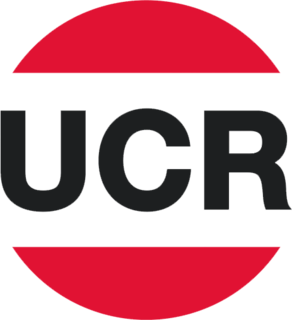
The Radical Civic Union is a centrist social-liberal political party in Argentina. The party has been ideologically heterogeneous, ranging from classical liberalism to social democracy. The UCR is a member of the Socialist International.

The University of Buenos Aires is the largest university in Argentina and the second largest university by enrollment in Latin America. Founded on August 12, 1821 in the city of Buenos Aires, it consists of 13 departments, 6 hospitals, 10 museums and is linked to 4 high schools: Colegio Nacional de Buenos Aires, Escuela Superior de Comercio Carlos Pellegrini, Instituto Libre de Segunda Enseñanza and Escuela de Educación Técnica Profesional en Producción Agropecuaria y Agroalimentaria.
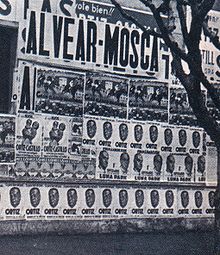
The movement which displaced them in 1916, the centrist, urban-oriented Radical Civic Union (UCR), turned to Marcelo Torcuato de Alvear for leadership following the military overthrow of its long-time leader and Alvear's rival, Hipólito Yrigoyen, in 1930. The scion of one of Argentina's traditional landed families and President from 1922 to 1928 (when his alliance with Yrigoyen soured), Alvear was respected largely for challenging Yrigoyen's personality cult (hence his reputation as the leading "Antipersonalist") and for his decision to boycott the 1931 election, given its uneven playing field. [2] [3]

Máximo Marcelo Torcuato de Alvear Pacheco, better known as Marcelo T. de Alvear was an Argentine politician and President of Argentina October 12, 1922 to October 12, 1928.

Juan Hipólito del Sagrado Corazón de Jesús Yrigoyen was a two-time President of Argentina who served his first term from 1916 to 1922 and his second term from 1928 to 1930.
Negotiations between President Justo and Alvear, who was allowed to return from exile, led to the UCR's lifting of its electoral boycott and to its resurgence by its election in 1936 of Amadeo Sabattini as Governor of Córdoba Province as well as victories in Tucumán Province and in Legislative elections (where despite Justo's orchestrated fraud, they obtained 56 of 158 seats - one more than the Concordance's Congressional stand-ins, the National Democrats). [4] [3]
Amadeo Tomás Sabattini was an Argentine politician. He served as Governor of Córdoba from May 17, 1936, to May 17, 1940.

Tucumán is the most densely populated, and the second-smallest by land area, of the provinces of Argentina. Located in the northwest of the country, the province has the capital of San Miguel de Tucumán, often shortened to Tucumán. Neighboring provinces are, clockwise from the north: Salta, Santiago del Estero and Catamarca. It is nicknamed El Jardín de la República, as it is a highly productive agricultural area.

The UCR nominated the elder statesman its standard bearer in 1937. A seasoned campaigner, Alvear made a compelling choice for his running mate, former Congressman Enrique Mosca. A vocal opponent of the 1930 Coup d'état despite his differences with President Yrigoyen, Mosca spent the next three and a half years in Ushuaia's notorious prison (now a museum). Alvear was not universally supported by Argentine progressives, however, and he failed to secure the endorsement of Arturo Jauretche's influential pro-industrialization political action committee, FORJA. Alvear was also deprived of a strong potential ally when the leader of the Democratic Progressive Party (PDP), Lisandro de la Torre, resigned from the Senate in protest over his inability to thwart the prevailing climate of corruption and impunity. His running mate in 1931, Nicolás Repetto, accepted the Socialist Party's nomination. Senator de la Torre's attempted assassination and the 1936 removal of the PDP's sole governor, Luciano Molinas of Santa Fe Province, became poster children of the "patriotic fraud" that set the stage for the 1937 elections. [5]
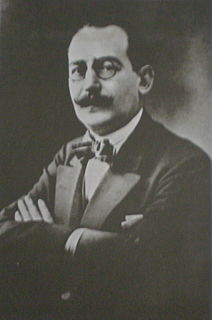
Enrique Mosca was an Argentine lawyer and politician prominent in the centrist Radical Civic Union (UCR).

Ushuaia is the capital of Tierra del Fuego, Antártida e Islas del Atlántico Sur Province, Argentina. It is commonly regarded as the southernmost city in the world. Ushuaia is located in a wide bay on the southern coast of Isla Grande de Tierra del Fuego, bounded on the north by the Martial mountain range, and on the south by the Beagle Channel. It is the only municipality in the Department of Ushuaia, which has an area of 9,390 km2 (3,625 sq mi). It was founded October 12 of 1884 by Augusto Lasserre and is located on the shores of the Beagle Channel surrounded by the mountain range of the Martial Glacier, in the Bay of Ushuaia. Besides being an administrative center, it is a light industrial port and tourist hub.
Arturo Martín Jauretche was an Argentine writer, politician, and philosopher.
President Justo left his party's nomination to its most influential voice, British commercial interests. Dominating his administration's trade and budgetary policies since the Roca-Runciman Treaty of 1933, they advanced the lead attorney for one of the largest British-owned railway carriers as the ruling party's nominee: Roberto Ortiz. Their considerations outweighed others in the party, whose conservatism clashed with the pragmatic Ortiz. The talented lawyer assuaged tensions at the party's July convention by choosing Ramón Castillo, an ultraconservative lawmaker from then-feudal Catamarca Province, as his running mate (this seemingly token gesture was quite significant: Ortiz suffered from advanced Type II diabetes). [6]
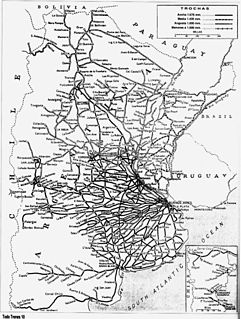
The Argentine railway network consisted of a 47,000 km (29,204 mi) network at the end of the Second World War and was, in its time, one of the most extensive and prosperous in the world. However, with the increase in highway construction, there followed a sharp decline in railway profitability, leading to the break-up in 1993 of Ferrocarriles Argentinos (FA), the state railroad corporation. During the period following privatisation, private and provincial railway companies were created and resurrected some of the major passenger routes that FA once operated.
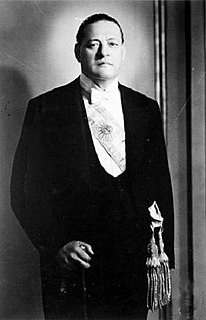
Jaime Gerardo Roberto Marcelino María Ortiz Lizardi was President of Argentina from February 20, 1938 to June 27, 1942.
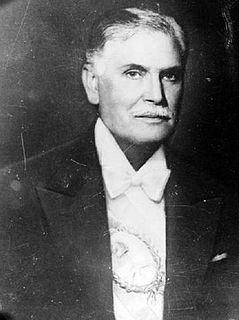
Ramón Antonio Castillo Barrionuevo was a conservative Argentine politician who served as President of Argentina from June 27, 1942 to June 4, 1943. He was a leading figure in the period known as the Infamous Decade, characterised by electoral fraud, corruption, and rule by conservative landowners heading the alliance known as the Concordancia.
Flouting his 1935 gentlemen's agreement with Alvear, Justo kept his political and security forces occupied on election day, September 5. Amid widespread reports of intimidation, ballot stuffing and voter roll tampering (whereby, according to one observer, "democracy was extended to the hereafter"), Ortiz won the elections handily. [7] One of the beneficiaries of the system of "patriotic fraud" advanced during the "Infamous Decade," Buenos Aires Province Governor Manuel Fresco, himself termed the 1937 Argentine general elections as "one of the most fraudulent in history" [8] (Fresco was himself removed by President Ortiz's decree in 1940 at the behest of ultraconservatives). [9]
Electoral fraud, sometimes referred to as election fraud, election manipulation or vote rigging, is illegal interference with the process of an election, either by increasing the vote share of the favored candidate, depressing the vote share of the rival candidates, or both. What exactly constitutes electoral fraud varies from country to country.

The Infamous Decade in Argentina is the name given to the period of time that began in 1930 with the coup d'état against President Hipólito Yrigoyen by José Félix Uriburu and resulted in the rising to power of Juan Perón after the Military coup of 1943. This decade was marked by significant rural exodus, many small rural landowners being ruined by the Great Depression, which in turn pushed the country towards import substitution industrialization. The poor economic results of the policy and popular discontent led to another coup in 1943, the "Revolution of '43", by the Grupo de Oficiales Unidos (GOU), the nationalist faction of the Armed Forces, against acting president Ramón Castillo, putting an end to the Infamous Decade.

Buenos Aires is the largest and most populous Argentinian province. It takes the name from the city of Buenos Aires, which used to be part of the province and the provincial capital until it was federalized in 1880. Since then, in spite of bearing the same name, the province does not include the national capital city proper, though it does include all other localities of the Greater Buenos Aires metropolitan area surrounding it. The current capital of the province is the city of La Plata, founded in 1882.
With a turnout of 76.2%, it produced the following official results:
| Party/Electoral Alliance | Votes | Percentage | Electoral College |
|---|---|---|---|
| National Democratic Party - Concordance alliance | 1,094,685 | 53.8% | 245 |
| Radical Civic Union (UCR) | 814,750 | 41.5% | 127 |
| Socialist Party | 50,917 | 2.6% | |
| Others | 2,585 | 0.1% | |
| Positive votes | 1,962,837 | 96.4% | 372 |
| blank or nullified votes | 72,902 | 3.6% | 4 a |
| Total votes | 2,035,839 | 100.0% | 376 |
aAbstentions. [4]

Agustín Pedro Justo Rolón was President of Argentina from February 20, 1932, to February 20, 1938. He was a military officer, diplomat, and politician, and was president during the Infamous Decade.

Lisandro de la Torre was an Argentine politician, born in Rosario, province of Santa Fe.
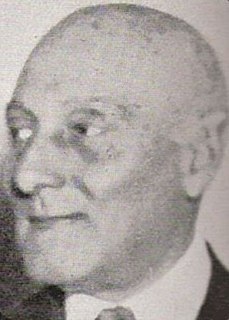
Leopoldo Melo was an Argentine lawyer, diplomat and politician. He was a leading figure in the Radical Civic Union, a nominee for President, and later Minister of Internal Affairs.
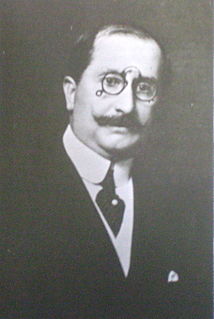
Vicente Gallo was an Argentine lawyer, academic and politician of the Radical Civic Union.

The Argentine presidential election of 1931 was held on 8 November. With a turnout of 73.4%, it produced the following official results:

The Argentine general election of 1928 was held on 1 April, with a turnout of 80.9%.

The Argentine general election of 1922 was held on 2 April. There was a turnout of 55.2%.

Nicolás Repetto was an Argentine physician and leader of the Socialist Party of Argentina.
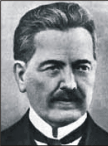
The Argentine general election of 1916 was held on 2 April. Voters elected the President, legislators, and local officials. The first secret-ballot presidential elections in the nation's history, they were mandatory and had a turnout of 62.7%.

José Tamborini was an Argentine physician and historically significant politician.

Félix Luna was an Argentine writer, lyricist and historian.
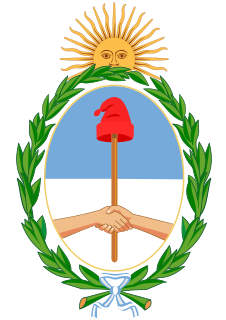
Argentine legislative elections of 1912 were held on 7 April 1912 for the Argentine Chamber of Deputies. The first free, democratic elections in the nation's history, the contest had a turnout of 68.5% and produced the following official results:

The Argentine legislative elections of 1914 were held on 22 March. Voters chose their legislators, and with a turnout of 55.7%, it produced the following results:
The Argentine legislative elections of 1924 were held on 7 March. Voters chose their legislators and numerous governors, and with a turnout of 44.2%, it produced the following results:
The Argentine legislative elections of 1926 were held on 7 March. Voters chose their legislators and numerous governors, and with a turnout of 49.2%, it produced the following results:
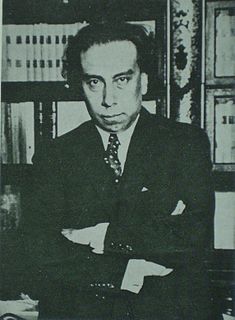
Mario Bravo was an Argentine politician and writer.
The Concordancia was a political alliance in Argentina. Three Presidents belonging to the Concordance were in power from 1931 to 1943, a period known in Argentina as the "Infamous Decade."